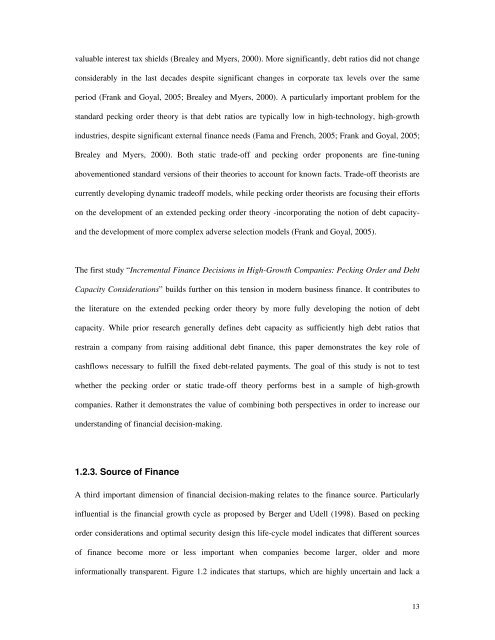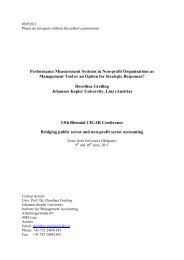Financing Unquoted High-Growth Companies: From Extending
Financing Unquoted High-Growth Companies: From Extending
Financing Unquoted High-Growth Companies: From Extending
You also want an ePaper? Increase the reach of your titles
YUMPU automatically turns print PDFs into web optimized ePapers that Google loves.
valuable interest tax shields (Brealey and Myers, 2000). More significantly, debt ratios did not change<br />
considerably in the last decades despite significant changes in corporate tax levels over the same<br />
period (Frank and Goyal, 2005; Brealey and Myers, 2000). A particularly important problem for the<br />
standard pecking order theory is that debt ratios are typically low in high-technology, high-growth<br />
industries, despite significant external finance needs (Fama and French, 2005; Frank and Goyal, 2005;<br />
Brealey and Myers, 2000). Both static trade-off and pecking order proponents are fine-tuning<br />
abovementioned standard versions of their theories to account for known facts. Trade-off theorists are<br />
currently developing dynamic tradeoff models, while pecking order theorists are focusing their efforts<br />
on the development of an extended pecking order theory -incorporating the notion of debt capacity-<br />
and the development of more complex adverse selection models (Frank and Goyal, 2005).<br />
The first study “Incremental Finance Decisions in <strong>High</strong>-<strong>Growth</strong> <strong>Companies</strong>: Pecking Order and Debt<br />
Capacity Considerations” builds further on this tension in modern business finance. It contributes to<br />
the literature on the extended pecking order theory by more fully developing the notion of debt<br />
capacity. While prior research generally defines debt capacity as sufficiently high debt ratios that<br />
restrain a company from raising additional debt finance, this paper demonstrates the key role of<br />
cashflows necessary to fulfill the fixed debt-related payments. The goal of this study is not to test<br />
whether the pecking order or static trade-off theory performs best in a sample of high-growth<br />
companies. Rather it demonstrates the value of combining both perspectives in order to increase our<br />
understanding of financial decision-making.<br />
1.2.3. Source of Finance<br />
A third important dimension of financial decision-making relates to the finance source. Particularly<br />
influential is the financial growth cycle as proposed by Berger and Udell (1998). Based on pecking<br />
order considerations and optimal security design this life-cycle model indicates that different sources<br />
of finance become more or less important when companies become larger, older and more<br />
informationally transparent. Figure 1.2 indicates that startups, which are highly uncertain and lack a<br />
13

















